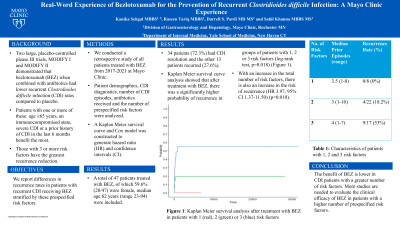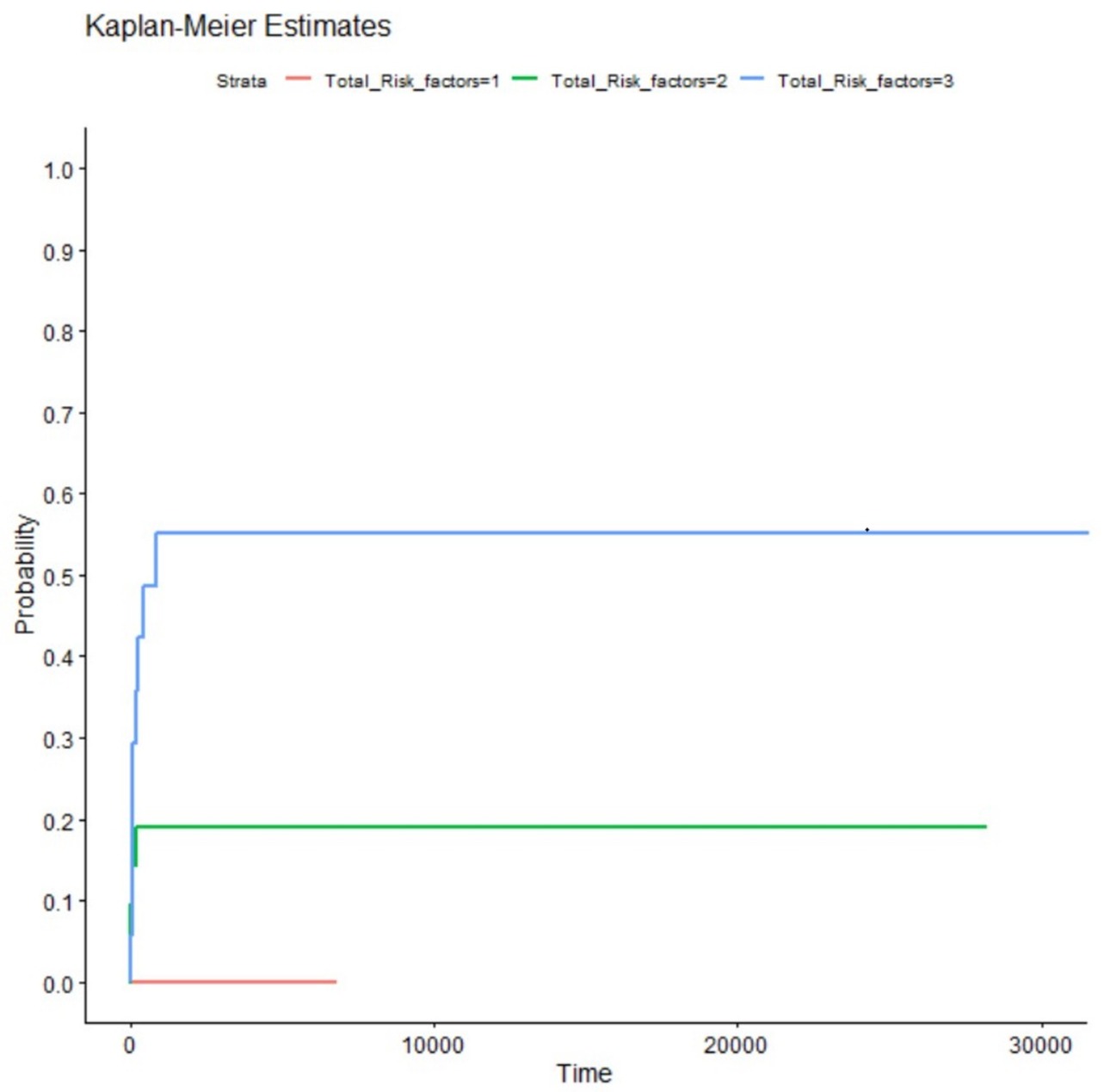Back


Poster Session C - Monday Afternoon
Category: Colon
C0105 - Real World Experience of Bezlotoxumab for the Prevention of Recurrent Clostridioides difficile Infection: A Mayo Clinic Experience
Monday, October 24, 2022
3:00 PM – 5:00 PM ET
Location: Crown Ballroom

Has Audio

Kanika Sehgal, MBBS
Yale New Haven Hospital
Rochester, MN
Presenting Author(s)
Kanika Sehgal, MBBS1, Raseen Tariq, MD2, Darrell S. Pardi, MD, MS, FACG2, Sahil Khanna, MBBS, MS, FACG2
1Yale New Haven Hospital, Rochester, MN; 2Mayo Clinic, Rochester, MN
Introduction: Two large placebo-controlled phase III trials demonstrated that bezlotoxumab when combined with antibiotics had lower recurrent Clostridioides difficile infection (CDI) rates compared to placebo. Patients with one or more of these: age ≥65 years, an immunocompromised state, severe CDI or a prior history of CDI in the last 6 months benefit the most. Those with 3 or more risk factors have the greatest recurrence reduction. We report differences in recurrence rates in patients with recurrent CDI receiving bezlotoxumab stratified by these prespecified risk factors.
Methods: We conducted a retrospective study of all patients treated with bezlotoxumab from 2017-2021 at Mayo Clinic. Patient demographics, CDI diagnostics, number of CDI episodes, antibiotics received and the number of prespecified risk factors were analyzed. Recurrence was defined as a subsequent CDI episode within 56 days of the previous episode. A Kaplan Meier survival curve and Cox model was constructed to generate hazard ratio (HR) and confidence intervals (CI).
Results: A total of 47 patients treated with bezlotoxumab, of which 59.6% (28/47) were female, with median age 62 years (range 23-94) were included. Patients had a median of 3 prior CDI episodes (range 1-10) (Table 1). Of these, 34 patients (72.3%) had CDI resolution and the other 13 patients recurred (27.6%). Recurrence rates with different number of risk factors is displayed in Table 1. Kaplan Meier survival curve analysis showed that after treatment with bezlotoxumab, there was a significantly higher probability of recurrence in groups of patients with 1, 2 or 3 risk factors (log-rank test, p=0.018) (Figure 1). With an increase in the total number of risk factors, there is also an increase in the risk of recurrence (HR 3.97, 95% CI 1.37-11.50) (p=0.010).
Discussion: The benefit of bezlotoxumab treatment is lower in CDI patients with a greater number of risk factors. More studies are needed to evaluate the clinical efficacy of bezlotoxumab in patients with a higher number of prespecified risk factors.

Disclosures:
Kanika Sehgal, MBBS1, Raseen Tariq, MD2, Darrell S. Pardi, MD, MS, FACG2, Sahil Khanna, MBBS, MS, FACG2. C0105 - Real World Experience of Bezlotoxumab for the Prevention of Recurrent Clostridioides difficile Infection: A Mayo Clinic Experience, ACG 2022 Annual Scientific Meeting Abstracts. Charlotte, NC: American College of Gastroenterology.
1Yale New Haven Hospital, Rochester, MN; 2Mayo Clinic, Rochester, MN
Introduction: Two large placebo-controlled phase III trials demonstrated that bezlotoxumab when combined with antibiotics had lower recurrent Clostridioides difficile infection (CDI) rates compared to placebo. Patients with one or more of these: age ≥65 years, an immunocompromised state, severe CDI or a prior history of CDI in the last 6 months benefit the most. Those with 3 or more risk factors have the greatest recurrence reduction. We report differences in recurrence rates in patients with recurrent CDI receiving bezlotoxumab stratified by these prespecified risk factors.
Methods: We conducted a retrospective study of all patients treated with bezlotoxumab from 2017-2021 at Mayo Clinic. Patient demographics, CDI diagnostics, number of CDI episodes, antibiotics received and the number of prespecified risk factors were analyzed. Recurrence was defined as a subsequent CDI episode within 56 days of the previous episode. A Kaplan Meier survival curve and Cox model was constructed to generate hazard ratio (HR) and confidence intervals (CI).
Results: A total of 47 patients treated with bezlotoxumab, of which 59.6% (28/47) were female, with median age 62 years (range 23-94) were included. Patients had a median of 3 prior CDI episodes (range 1-10) (Table 1). Of these, 34 patients (72.3%) had CDI resolution and the other 13 patients recurred (27.6%). Recurrence rates with different number of risk factors is displayed in Table 1. Kaplan Meier survival curve analysis showed that after treatment with bezlotoxumab, there was a significantly higher probability of recurrence in groups of patients with 1, 2 or 3 risk factors (log-rank test, p=0.018) (Figure 1). With an increase in the total number of risk factors, there is also an increase in the risk of recurrence (HR 3.97, 95% CI 1.37-11.50) (p=0.010).
Discussion: The benefit of bezlotoxumab treatment is lower in CDI patients with a greater number of risk factors. More studies are needed to evaluate the clinical efficacy of bezlotoxumab in patients with a higher number of prespecified risk factors.

Figure: Kaplan-Meier curve depicting probability of recurrence of Clostridioides difficile infection with 1, 2 or 3 risk factors after treatment with bezlotoxumab
| No. of Risk Factors | Median Prior Episodes (range) | Recurrence Rate (%) |
| 1 | 3.5 (1-8) | 0/8 (0%) |
| 2 | 3 (1-10) | 4/22 (18.2%) |
| 3 | 4 (1-7) | 9/17 (53%) |
Table: Median prior episodes of Clostridioides difficile and recurrence rates associated with 1, 2 or 3 risk factors in patients treated with bezlotoxumab
Disclosures:
Kanika Sehgal indicated no relevant financial relationships.
Raseen Tariq indicated no relevant financial relationships.
Darrell Pardi: Abbvie – Consultant. Boehringer Ingelheim – Consultant. Ferring – Consultant. Finch – Grant/Research Support. Immunic – Consultant. Merck – Consultant. Otsuka – Consultant. Rebiotix – Grant/Research Support. Seres – Grant/Research Support. Takeda – Grant/Research Support. Vedanta – Consultant.
Sahil Khanna: Ferring Pharmaceuticals – Grant/Research Support. Finch – Grant/Research Support. Niche – Consultant. Pfizer – Grant/Research Support. Probiotech – Consultant. Seres Therapeutics – Grant/Research Support. Takeda/Shire – Consultant. Vedanta – Grant/Research Support.
Kanika Sehgal, MBBS1, Raseen Tariq, MD2, Darrell S. Pardi, MD, MS, FACG2, Sahil Khanna, MBBS, MS, FACG2. C0105 - Real World Experience of Bezlotoxumab for the Prevention of Recurrent Clostridioides difficile Infection: A Mayo Clinic Experience, ACG 2022 Annual Scientific Meeting Abstracts. Charlotte, NC: American College of Gastroenterology.

